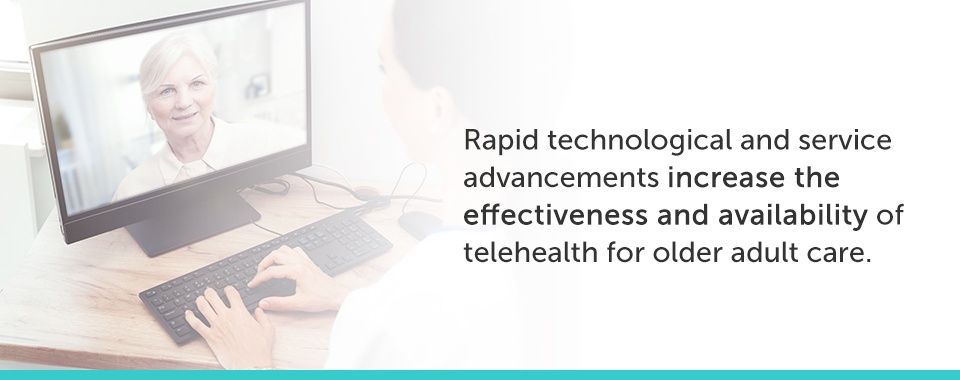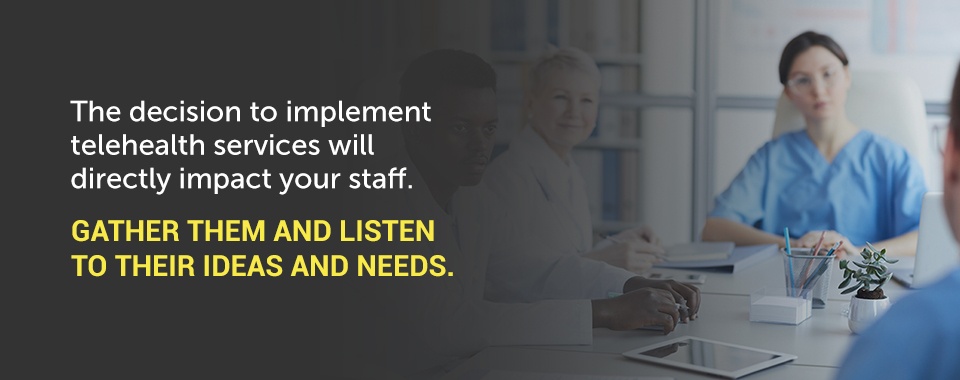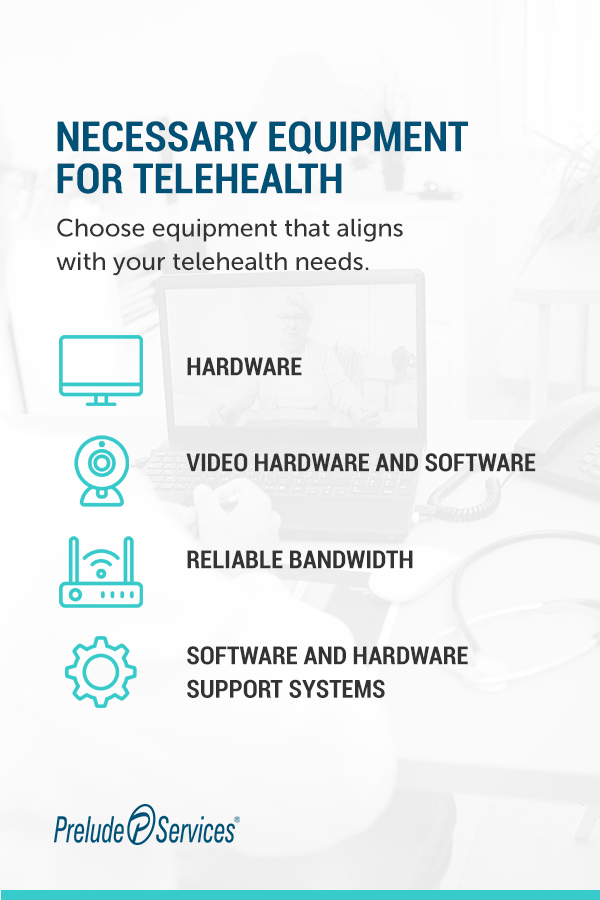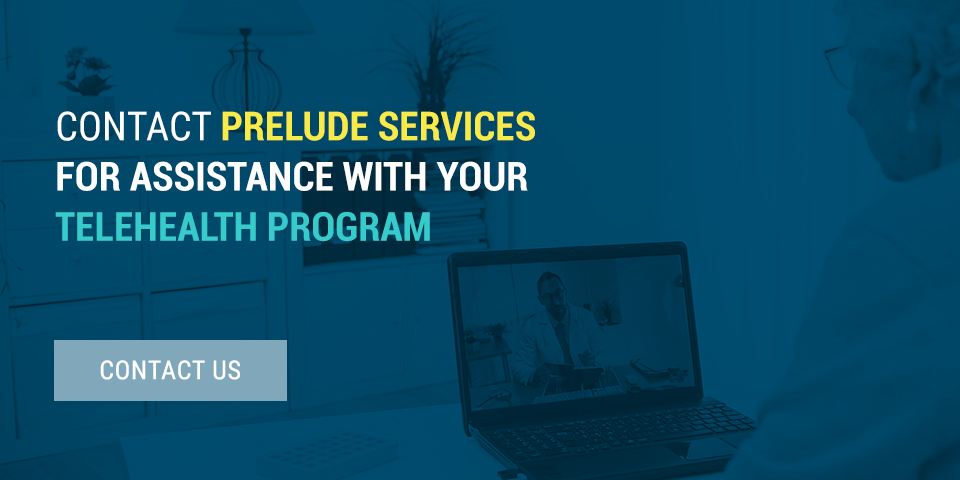
How to Provide Telehealth in Nursing Homes
As the baby boomer generation gets older, more older adults require telehealth in long-term care (LTC) from nursing homes and retirement communities. Compared to traditional healthcare services provided in offices and hospitals, telehealth is a rapidly expanding form of service, requiring updated technology to bridge the gap between quality and at-home healthcare.
What Is Telehealth?
Telehealth is rapidly changing the way businesses operate, broadly defined as the use of telecommunication and information technology to provide long-distance healthcare to patients. The Centers for Medicare and Medicaid Services (CMS) cover telehealth services like:
- Inpatient consultations
- Follow-up consultations
- Individual psychotherapy
- Psychiatric examinations
- Intervention services
- Pharmaceutical management
This two-way, real time communication process takes place in two sites:
- Distant site: This is where the practitioner administers the service.
- Originating site: This is the location of the patient at the time of service.
Some examples of how to provide telehealth in nursing homes include:
- Videoconferencing
- Telephone conferencing
- Electronic mailing systems
- Fax machines
- Remote patient monitoring
If you plan on implementing telehealth services, you need, at a minimum, audio and video equipment. This allows you to maintain the feeling of human interaction with patients, even if through a screen, a requirement set by CMS.
Benefits of Telehealth in Nursing Homes
Implementing telehealth in retirement homes and nursing facilities, especially when aligned with the company’s organizational goals and workflow, offers extensive benefits. When properly applied, you can expect benefits like:
- Increased access to other skilled physicians: A telehealth platform gives staff the link to on-demand support whenever they need it, making them more reactive when administering care.
- Improved patient care: The ability to receive on-demand support leads to smoother operations and increased confidence in staff members. Technological advances enhance organizational workflow by eliminating unnecessary complications, like loss of paperwork or slow response times, aiding the increased level of confidence.
- Reduced stress on patients and family members: The increased accessibility to comprehensive care makes patients and family members feel more confident, too. A bonus, telehealth eliminates the sometimes stressful situation of transportation to the healthcare provider.
An increase in patients’ access to healthcare eliminates avoidable Medicare penalties, like unnecessary hospitalizations, promoting smoother operations for a healthier workplace environment.
What to Know Before Providing Telehealth in Nursing Homes

Rapid technological and service advancements increase the effectiveness and availability of telehealth for older adult care. These advancements also impact the rules and regulations set on healthcare providers. Familiarize yourself with some of these rules and regulations before formulating an implementation strategy.
1. BECOME FAMILIAR WITH FEDERAL AND STATE LAWS
Laws differ by state, so it’s important to research your state’s regulations before creating a telehealth strategy. Additionally, continuous technological and interpersonal advancements impact which types of telehealth services are reimbursable, which may affect your decisions. Current state laws and regulations include:
- Reimbursement of live video in Medicaid fee-for-service
- Reimbursement in 14 states for store-and-forward
- Reimbursement for remote patient monitoring (RPM) in 22 state Medicaid programs
- Limit of the types of facilities allowed to serve as an originating site in 23 states
- Transmission of facility fee in 34 state Medicaid programs
Federal level policy changes have a ripple effect across state policies, increasing the importance of staying knowledgable on these rapid developments.
2. MEET PRIVACY AND DATA SECURITY STANDARDS
All medical records, even those outside of telehealth, are subjected to HIPAA’s Privacy Rule, enforced by the Office for Civil Rights (OCR). This rule sets a national standard for the protection of patients’ records and other personal information, including:
- Past, present or future physical or mental health
- Provision of healthcare
- Past, present or future payment of healthcare
HIPAA’s Security Rule applies directly to electronically-transmitted documents, providing the same level of patient protection. This rule is increasingly important with the rapid developments of technology and is designed to be flexible to accommodate the growth rate.
These rules protect the flow of health information within and between healthcare providers, ensuring patients receive quality health care with respect to their privacy. The patient, clearly, has access to their documents and has the right to request full disclosure of their information.
3. INFORM PATIENTS OF APPROPRIATE INFORMATION
Following the rules stated by HIPAA, healthcare providers must disclose the appropriate information to patients, allowing patients to make the voluntary decision to receive or refuse telecare. Providers must disclose the following information:
- Limitations to confidentiality
- Methods of alternative communications should technology fail
- Communication methods between sessions
- Process of documentation and storage
- Conditions of the termination of telehealth services in the event of a face-to-face referral
In summary, before implementing telehealth services, do your research. You want to be fully aware of the legal responsibilities that accompany their implementation, or you could subject yourself to the legal repercussions if neglected.
How to Implement Telehealth in Nursing Homes
Communication between patients and staff is vital when considering implementing these new services and the safety of both groups. To smoothly implement telehealth in nursing homes, follow these three steps:

1. MAKE SURE YOUR STAFF IS ONBOARD
The decision to implement telehealth services will directly impact your staff. Gather them and listen to their ideas and needs. Do they need any new technology to administer teleservices? If your business already offers these forms of treatment, does your staff need upgraded technology to accommodate the increasing number of telehealth patients?
By making sure you hear and support your staff’s needs, you encourage smooth online transition and operational flow. The increased confidence within your staff will be apparent to your patients, making them feel more confident about the new service.
2. ENSURE YOUR CLIENTS HAVE THE NECESSARY RESOURCES
Consider that many older adults don’t have a cellphone or personal computer. Even with access to telecommunication devices, they may not know how to use them, compared to younger generations who have been using this technology since childhood. Supplying a communication device yourself and providing them with the resources to use them may be necessary.
Keep in mind that some older patients may not feel comfortable or confident receiving telehealth services, purely due to their lack of experience with the communication device. Educate your staff on techniques to ease these concerns.
3. ESTABLISH SAFETY AND EMERGENCY PLANS
No matter the form of service, the safety of both patients and providers is of utmost importance. During a session, ensure patients are not at risk of causing harm to themselves or others, evaluate worsening symptoms and be aware of any access to firearms and the chance of medical emergencies.
Develop clearly defined safety procedures and emergency protocols before implementing teleservices to better prepare yourself and staff in the event of a technical, psychiatric or medical emergency. Procedures and protocols should include:
- Establishing back-up plans should connection or technology fail
- Screening and assessment of patients
- Asking for the patient’s physical location should emergency services be requested
Review these safety and emergency plans with your patients and staff. Currently, there is no evidence that indicates telehealth services are less safe than traditional in-office services, but it’s always best to be prepared.
How to Set up Remote Patient Monitoring
RPM is a proactive care strategy that allows providers to gather clients’ health information remotely, bypassing tedious trips to the doctor’s office or hospital. This form of care is unique to the patient’s condition and goals, so the setup in relation to devices, platforms and applications may be different.
Because RPM is personalized per patient, your staff should be trained in multiple lines of support and be capable of educating their patients on the remote technology used during treatment.
Healthcare facilities are transitioning to cloud computing to store and retrieve their patient’s data. Cloud computing improves efficiency, limits unnecessary paperwork with an infinite amount of data storage and gives providers mobile access to communicate and coordinate tasks from any location.
This rapid form of digital communication is important when evaluating a remote patient’s condition. When setting up RPM, choose reliable technology with efficient response times to provide quality telehealth services.

Necessary Equipment for Telehealth
When choosing equipment, ask yourself if the item is important to deliver telehealth services, both from the client’s and the provider’s perspectives. Identify an appropriate amount of space to house your technology within your distant site. Choose equipment that aligns with your telehealth needs. At a minimum, you will need:
- Hardware: Hardware is the tools and equipment used to provide service. This includes a computer, a high definition video camera and an audio system that sets a solid foundation for video conferencing sessions.
- Video hardware and software: The goal of communicating with your patients online is to give them the same level of care received during in-house treatment. Use a secure and reliable video medium, set up your camera at eye-level to prevent looking down at your patient and use a high definition camera to avoid pixelated, disruptive imaging.
- Reliable bandwidth: The speed and capacity of transferring data are crucial to a smooth, reliable connection. Ensure adequate bandwidth for telecommunication from your internet service provider or IT agency.
- Software and hardware support systems: Software support systems will keep programs and applications well maintained, such as email services, security software, web browsers, data management and bookkeeping. Hardware support systems will maintain the structure of the physical devices, or “homes”, for the software.
For technical support, contact an IT agency. They will help determine which hardware and software you need to execute your services while meeting HIPAA requirements.
Telehealth Checklist for Nursing Homes
Health services are rapidly changing with the development of new technology. Follow these steps to receive the benefits of providing telehealth to your patients:
1. IDENTIFY YOUR MISSION AND GOALS
Determine why you want to offer telehealth services. What is your goal? Why is it important to you? If you feel confident that these services are beneficial to both patients and staff, implement them in alignment with your company’s mission and vision statement.
2. FAMILIARIZE YOURSELF WITH HIPAA RULES AND REGULATIONS
The American Telemedicine Association (ATA) works directly with Congress to ensure safe and effective telehealth practices. This organization is a great place to start familiarizing yourself with federal and state laws when considering implementing teleservices.
Consider how you will maintain your patients’ safety and privacy and the best way to communicate their rights. Telehealth may be foreign to older adults, increasing the importance of emphasizing their rights during the telehealth process to make them feel more comfortable.
3. MANAGE YOUR LICENSES
Having a multi-state license may be beneficial for telehealth, and some states even developed an out-of-state telehealth license to allow the administering of care across state lines. Before providing telehealth services to your patients, be sure to obtain the appropriate license required by your state.
4. ASSESS NEEDS AND READINESS
If you currently offer a form of telehealth, determine whether your operations are capable of increasing these services to a larger number of patients. Do you have the appropriate amount of space? Does it make sense for you to offer these services remotely? Is your staff trained in these services?
Gather your staff and ask them directly what their needs are. Communication plays a crucial role in the smooth integration of telehealth, so listen to their needs carefully. You may also consider asking some of your patients what their needs are. Make a list of these gaps to develop an accurate implementation procedure.
5. DEVELOP A POLICY
Based on the gaps identified, determine what services to provide. Develop consent procedures, reimbursement procedures, emergency and safety plans, training requirements and staff responsibilities. These policies are critical in determining the quality of care your patients will receive and the efficiency of operations related to HIPAA requirements.
6. GATHER EQUIPMENT
At a minimum, you will need a reliable computer, high definition camera and audio system. Your camera should be of sufficient resolution, and your microphone should capture your voice and eliminate any outside noise to ensure the same quality of traditional in-office healthcare. Contact your IT agency for technical support and to ensure the telecommunication process is HIPAA-compliant.
7. SET UP YOUR TELEHEALTH SPACE
A telehealth space is a room where providers administer the service at the distant site. This room should be well lit, sound-proof, private and have limited distractions, much like a traditional office space.
Once you’ve followed these seven steps, you should be prepared to provide quality telehealth services to your patients. Every teleoperation has different requirements, meaning you will have to personalize some aspects. Track your progress continually and make adjustments as needed.
Contact Prelude Services for Assistance With Your Telehealth Program
No matter the size of your facility or expanse of telehealth operations, our experienced IT technicians are here to offer you strategic planning, support and management. We can help you incorporate reliable technology and equipment to provide quality health services for your remote patients.
When it comes to technical support, we understand that you can’t wait days or even hours for help. Our 24×7 Service Desk provides top-quality support that you can rely on, resolving problems quickly and efficiently so you can continue doing what you do best — providing quality care to your patients. Contact us today to transform your telehealth program.
CONTACT PRELUDE SERVICES FOR 24/7 IT SUPPORT
Technology has become a crucial part of the modern business experience. Without functional computers and mobile phones, many business practices would grind to a halt. Unfortunately, breakdowns and malfunctions are an inevitable part of any machine, meaning businesses do grind to a halt until the issues are fixed. In order to keep your business running, it's crucial to have access to IT support when you experience technical difficulties.
If you're a healthcare company, long-term care provider, or small business in need of IT support at all hours, consider Prelude Services. We're a SSAE SOC
Compliant business dedicated to improving your security and functionality. We offer specific IT services for senior living care, nursing homes, retirement home services and assisted living, including 24/7 IT support. If you want to know how Prelude can help you, contact us today!

